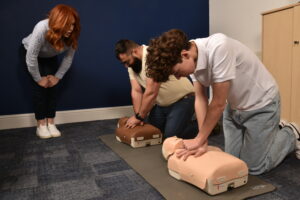First aid is one of the most important life skills anyone can learn. Whether at home, at work, or in public, quick action often starts with basic knowledge — and everyone should feel confident taking that first step.
Learning a few essential first aid skills helps you stay calm in an emergency, give the right care before professional help arrives, and make a real difference to someone’s outcome. These skills are not just for healthcare professionals — they’re for everyone.
1. Cardiopulmonary Resuscitation (CPR)
CPR is one of the most vital first aid skills. If someone’s heart has stopped, CPR helps maintain blood flow and oxygen to the brain until emergency services arrive.
Key points to remember:
- Check for a response and breathing
- Call 999 immediately
- Start chest compressions at 100–120 per minute
- Use a defibrillator (AED) if available
Even without full training, hands-only CPR can be highly effective and should be started as soon as possible.
2. First Aid and the Recovery Position
If a person is unconscious but breathing, the recovery position helps keep their airway open and prevents choking.
To do this:
- Roll the person onto their side
- Tilt the head back slightly to keep the airway clear
- Keep them warm and stay with them until help arrives
This simple action could prevent a life-threatening complications.
3. How to Control Severe Bleeding
Heavy bleeding can lead to shock and serious complications. Knowing how to stop bleeding effectively is an essential skill.
Steps to take:
- Apply firm, direct pressure to the wound
- Use a clean dressing or bandage
- Raise the injured limb if possible
- Do not remove any embedded objects—apply pressure around them
If bleeding is severe or doesn’t stop, call 999.
4. Helping Someone Who’s Choking
Choking can be sudden and frightening — but swift action is often enough to save a life.
For adults and children:
- Encourage them to cough if they can
- Give up to 5 back blows between the shoulder blades
- Follow with up to 5 abdominal thrusts if needed
- Alternate until the obstruction clears or help arrives
For babies under 1 year: use gentle back blows and chest thrusts instead — specialist first aid training is highly recommended.
5. Recognising a Heart Attack or Stroke
Knowing the warning signs and acting fast is critical.
Heart attack symptoms may include:
- Chest pain or tightness
- Pain spreading to the arm, neck or jaw
- Shortness of breath or nausea
Use the F.A.S.T. test for stroke:
- Face: one side drooping?
- Arms: can they lift both?
- Speech: is it slurred or confused?
- Time: call 999 immediately
Quick action increases the chance of recovery.
🔗 Stroke Association UK: What to do in a stroke
6. First Aid for Burns and Scalds
Burns are common in homes and kitchens, and knowing how to respond makes a big difference.
Steps to treat burns:
- Cool the area under cool running water for 20 minutes
- Remove tight clothing or jewellery (unless stuck to the skin)
- Cover with cling film or a clean dressing
- Avoid creams, ice, or toothpaste
Seek medical advice for deep, large, or facial burns.
🔗 NHS guide to burns and scalds
Everyone Should Know First Aid
These essential first aid skills can help you stay calm and act confidently when it counts. Whether you’re a parent, colleague, carer, or simply someone who wants to be prepared, learning first aid is one of the most valuable skills you can gain.
While reading is a great start, hands-on practice builds true confidence. Consider taking a certified first aid course to learn these techniques in a supportive environment.





